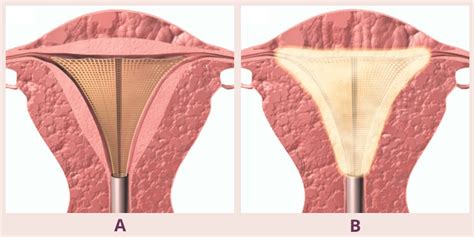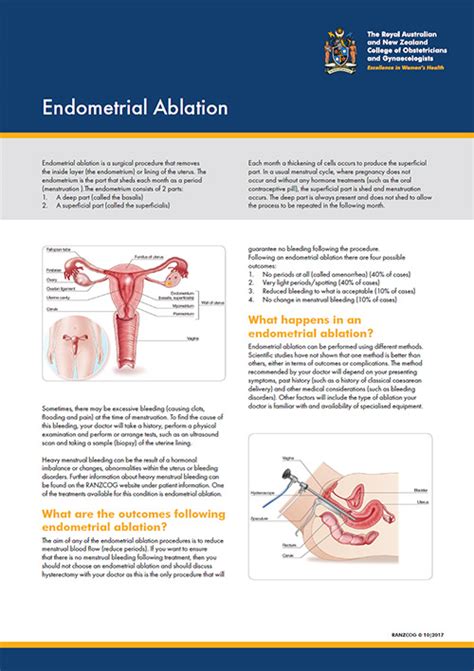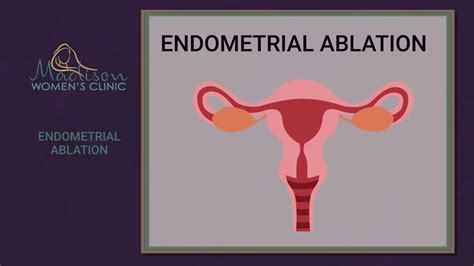Intro
Discover potential Endometrial Ablation side effects, including cramping, bleeding, and infection, and learn about minimally invasive treatment options for heavy menstrual bleeding, uterine lining removal, and hormone regulation.
Endometrial ablation is a minimally invasive surgical procedure that aims to treat abnormal uterine bleeding by destroying the lining of the uterus, known as the endometrium. This procedure has gained popularity in recent years due to its effectiveness in reducing or eliminating heavy menstrual bleeding, which can significantly improve the quality of life for many women. However, like any medical procedure, endometrial ablation comes with its own set of potential side effects and risks. Understanding these side effects is crucial for women considering this procedure, as it allows them to make informed decisions about their health care.
The importance of discussing endometrial ablation side effects cannot be overstated. While the procedure is generally safe, being aware of the possible complications can help manage expectations and ensure that patients are prepared for any outcomes. Furthermore, the decision to undergo endometrial ablation should be made after careful consideration and consultation with a healthcare provider, taking into account the individual's health status, medical history, and personal preferences. It is also essential to weigh the benefits of the procedure against the potential risks and side effects to make an informed decision.
For many women, the benefits of endometrial ablation, including the reduction or cessation of heavy menstrual bleeding, can greatly outweigh the risks. However, it is crucial to approach this decision with a comprehensive understanding of what to expect, including the potential side effects. By doing so, women can better navigate their treatment options and work closely with their healthcare providers to achieve the best possible outcomes. This article aims to provide a detailed overview of the side effects associated with endometrial ablation, helping readers make informed decisions about their reproductive health.
Introduction to Endometrial Ablation

Types of Endometrial Ablation
There are several types of endometrial ablation procedures, each utilizing different methods to destroy the endometrium. These include: - Radiofrequency ablation: This method uses a special device that emits radiofrequency energy to heat and destroy the endometrium. - Hydrothermal ablation: This involves circulating heated fluid within the uterus to destroy the endometrial lining. - Cryoablation: This method uses extremely cold temperatures to freeze and destroy the endometrial tissue. - Microwave ablation: This technique utilizes microwave energy to heat and destroy the endometrium. Each type of ablation has its own set of benefits and potential side effects, and the choice of procedure often depends on the individual's specific condition and the preferences of the healthcare provider.Potential Side Effects of Endometrial Ablation

Long-Term Effects and Risks
In addition to the immediate side effects, there are also long-term effects and risks to consider. These can include: - Regrowth of the endometrium: Over time, the endometrium can regrow, leading to a return of heavy menstrual bleeding. - Infertility: Endometrial ablation is not a form of sterilization, but it can reduce the chances of becoming pregnant. If pregnancy does occur after ablation, there is an increased risk of complications. - Hysterectomy: In some cases, endometrial ablation may not be effective, and a hysterectomy (surgical removal of the uterus) may be necessary. - Premature menopause: Although rare, endometrial ablation can lead to premature menopause in some women. It is essential to discuss these long-term effects and risks with a healthcare provider to understand the potential implications of the procedure.Preparation and Recovery

Managing Side Effects
Managing side effects is an essential part of the recovery process. This can include: - Pain management: Over-the-counter pain relievers or prescription medications may be used to manage cramping and discomfort. - Rest and hydration: Getting plenty of rest and staying hydrated can help the body recover more quickly. - Monitoring for complications: Patients should be aware of the signs of potential complications, such as heavy bleeding, severe pain, or fever, and seek medical attention if these symptoms occur. By taking proactive steps to manage side effects, patients can reduce their discomfort and promote a healthier recovery.Conclusion and Future Perspectives

Final Thoughts
Endometrial ablation is a significant step for many women, offering a chance to alleviate the symptoms of heavy menstrual bleeding and improve their quality of life. However, it is essential to approach this decision with a thorough understanding of the potential benefits and risks. By being informed and prepared, women can take control of their reproductive health and make decisions that align with their personal values and health goals.What is endometrial ablation, and how does it work?
+Endometrial ablation is a procedure that destroys the lining of the uterus to treat heavy menstrual bleeding. It works by using energy to destroy the endometrium, which reduces or stops menstrual bleeding.
What are the potential side effects of endometrial ablation?
+Potential side effects include cramping, nausea, discharge, infection, and perforation of the uterus. Long-term effects can include regrowth of the endometrium, infertility, and premature menopause.
How do I prepare for endometrial ablation, and what is the recovery process like?
+Preparation includes stopping certain medications, avoiding food and drink before the procedure, and arranging for post-procedure care. Recovery involves rest, avoiding heavy lifting, and following specific instructions from your healthcare provider.
We invite you to share your thoughts and experiences with endometrial ablation. Your insights can help others who are considering this procedure, and we encourage you to comment below. Additionally, if you found this article informative, please share it with others who may benefit from this information. Together, we can promote awareness and support for women's reproductive health.
